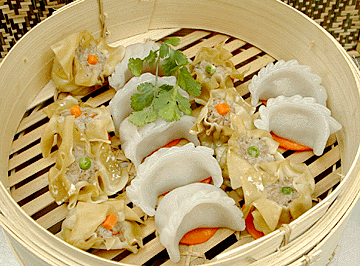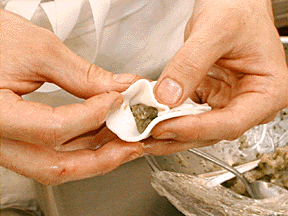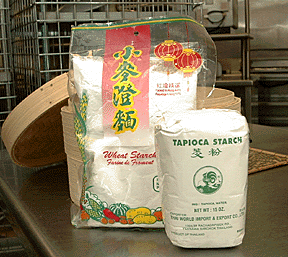


Celebrate the Lunar New Year
Story by Betty Shimabukuro
with these fancy snack foods
Star-BulletinOnce upon a time, the emperor's chef came to work drunk. He set about to make shrimp dumplings, but in his fuzzy state of mind used wheat starch instead of rice flour.
Big deal? Obviously you are not up on your starches, grasshopper. The gluten-free wheat starch, once steamed, produced a transparent wrapping that allowed the pink of the shrimp to show through as though wrapped in parchment.
The emperor thought it lovely. The chef was handsomely rewarded, although it was several days before he sobered up enough to enjoy it. And thus was born har gau, the delicate shrimp dumpling that is a staple of the dim sum menu.
This is the story Rhonda Fong Lee tells in "Dim Sum" (Taylor & Ng, 1997), and it must be true because she got it from her grandmother.

"Dim sum," literally means "dot heart," Fong says, or more poetically, "heart's delight," which can refer to the way the dumpling pleases, or the way the chef works to please the diner.At Kapiolani Community College, Alfredo Cabacungan is teaching a new generation of chefs to please the heart through mastery of this centuries-old snack food.
Cabacungan sees dim sum as a classic Chinese melding of frugality and creativity. "It's the innovation of the Chinese, of utilizing all the byproducts and making sure nothing is wasted," he says.
The ultimate example would be chicken feet, a dim sum sideline that is all bones and slimy skin -- definitely an acquired taste.



But as a whole, dim sum involves wrapping morsels of meat and vegetables in tiny circles -- or squares -- of dough that are then steamed, fried or baked. The result is delicate, artistic and delicious."All the little tidbits are gathered, put together in a palatable way," Cabacungan says.
His students at KCC's Institute for the Culinary Arts just wrapped up a two-week session on Chinese specialties as part of an advanced course in the cuisines of China and Southeast Asia.
They learn the making of dough and fillings, but also the critical technique of assembly, because dim sum is still made one-by-one, by hand.
Cabacungan has compiled recipes for three basic dumplings -- har gau (shrimp bonnet), siu mai (meat dumpling) and kuo teh (pot stickers).
(Fong relates another legend for pot stickers, also involving an inattentive emperor's chef: This one left the dumplings in the wok too long, browning them on one side. The chef's son told the emperor they weren't burned, but were a new creation, meant to be crunchy on the bottom. Once again, the emperor loved them.)
Cabacungan suggests a Lunar New Year's dim sum party, where the guests learn to wrap their own, then eat them right out of the steamer.
Edible art form
Where it began: Dim sum was invented as a bite-sized snack for emperors during China's Sung dynasty (960-1279).
Journey south: The Mongols pushed the emperor farther and farther south in the 13th century, until the royal court and its culinary traditions ended up in the Cantonese regions, considered the home of dim sum today.
The tea house: The equivalent of the corner bar or coffee shop, the tea house is the social gathering place in China. By 1900 dim sum was the tidbit of choice for eating with tea.
The male prerogative: For centuries, only men ate dim sum. Eventually, though, women began cooking it at home. Today dim sum is enjoyed by both genders and all social classes.
Two tips: Shop in Chinatown and don't cut too far back on the fat.
"Sometimes we have a tendency to be too fat-conscious and we reduce the fat to 5 percent or less -- and the result is it's too dry," Cabacungan says.
He's referring specifically to dim sum containing force meats, or finely ground pork, beef and shrimp. He recommends lean meats, but don't cut off all the visible fat. "Force meats should be 25 percent fat, minimum, for the right texture, taste, feel."

Best place to find some of these ingredients is Chinatown, Cabacungan says. Gluten-free wheat starch and tapioca flour, especially, might be difficult to find in supermarkets, but are available in Chinatown groceries. Won ton wrappers for steamed siu mai are best found in the noodle factories. Don't substitute wrappers meant for frying; those will come out tough.One more hint: To test flavorings for har gau or siu mai before steaming, make a small patty out of a tablespoon of filling and pan fry it. Taste and adjust the seasonings before making your first dumpling.
Master his basic recipes, then follow the Chinese example and experiment with the fillings. In China, he says, he's seen such creations as spinach with dried shrimp and zucchini with jellyfish. "The filling is a matter of creativity."
Har Gau
To make dough: Place starch, flour and salt in a mixer. Use dough hook at low speed and gradually add boiling water. Incorporate well. Add shortening and oil and mix thoroughly. If dough is too stiff, add 1 teaspoon of water.Dough:
2 cups gluten-free wheat starch
1 cup tapioca flour
1/2 teaspoon salt
1-3/4 cups boiling water
3 tablespoons shortening
1 to 2 teaspoons sesame oil
Filling:
1-1/2 pounds shrimp, peeled and diced
1/2 teaspoon ginger, minced fine
2 tablespoons Chinese parsley, minced
1 teaspoon salt
2 tablespoons cornstarch
1/4 teaspoon white pepper
2 teaspoons dry sherry
2 teaspoons peanut oil
2 teaspoons sesame oil
1 teaspoon soy sauce
1 teaspoon oyster sauceContinue to mix until a ball forms. Remove from the bowl and knead a few times by hand. Divide dough into four equal parts and wrap in plastic wrap until ready to use.
To form dough circles: Oil work surface and the blade of a cleaver. Shape each portion of dough into a sausage about 12 inches long, and cut into 1/2-inch pieces. Press with cleaver to form a circle about 3 inches across. Keep cleaver well-oiled as you press out more circles.
To make filling: Combine all ingredients and mix well. Set aside about 20 minutes.
Pick up a dough circle and fold 3-5 pleats on one side of the circle. Pinch to keep the pleats in place. Put about 1 tablespoon of filling into the dough circle, then fold the unpleated edge to meet the pleated edge and pinch to seal tightly. Fold corners inward slightly so dumpling resembles a nurse's cap.
Place dumplings, seam side up and without touching, in a single layer in a well-greased steamer. Or place each dumpling on a round slice of carrot to prevent sticking. Steam, covered, over boiling water for 15-18 minutes. Makes about 50 dumplings.
Approximate nutritional analysis, per dumpling: 55 calories, 1.5 g total fat, 0.5 g saturated fat, 25 mg cholesterol, 105 mg sodium.*
Siu Mai
2 pounds lean ground porkGrind pork and shrimp together and season with the rest of the ingredients.
1 pound ground shrimp
4 tablespoons Chinese parsley
2 teaspoons salt
1 ounce dry sherry
1 teaspoon MSG (optional)
1 teaspoon pepper
50 wonton skins (for steaming)Make a circle of the thumb and fingers of one hand; place a wonton skin over the hand. Place about 1-1/2 tablespoons of filling in the center of the wonton skin and push down into the circle of your fingers. The skin will form a pouch with the dough firmly pressed inside. Crimp the edges back. Dumpling will remain open-faced. Center may be garnished with a pea or a piece of vegetable or shrimp.
Place dumplings, without touching, in a single layer in a well-greased steamer or on top of round carrot slices. Steam 15-20 minutes. Makes 50.
Approximate nutritional analysis, per dumpling: 90 calories, 4 g total fat, 1.5 g saturated fat, 30 mg cholesterol, 115 mg sodium (125 mg sodium with MSG).*
Pot Stickers
50 siu mai or mandoo wrappersCombine filing ingredients and mix well.
Salad oil for frying
Chicken stock to moisten
Filling:
1 pound freshly ground pork
2 cups won bok, shredded
1/4 cup green onions, chopped
1 tablespoon ginger, minced
1 teaspoon soy sauce
1 teaspoon salt
2 teaspoons sesame oil
1 teaspoon sherry
1/2 teaspoon sugar
1 tablespoon cornstarchPlace about 2 teaspoons of filling in the center of each wrapper, wet the edge, fold the wrapper in half over the filling and seal. Make pleats around the edge. Press to flatten the bottom.
Heat a small amount of oil in the skillet and fry until lightly browned on both sides. Pour just enough stock into the pan to cover the bottom and keep dumplings from sticking. Cook until stock is absorbed. Makes 40-50 dumplings.
Approximate nutritional analysis, per dumpling: 60 calories, 2 g total fat, 1 g saturated fat, 10 mg cholesterol, 55 mg sodium.*
This vegetarian dim sum features minced spinach and shiitake mushrooms and contains just 1 gram of fat per serving -- and that's 6 dumplings. For the vegetarian
dim sum loverThe recipe comes from Sarah Schlesinger's "500 More Fat-Free Recipes," which contains only recipes that conform to the FDA's low-fat guideline of 3 grams of fat or less per serving.
Vegetable Dumplings
"500 More Fat-Fres Recipes" (Villard, 1998, $25)2 cups minced shiitake mushroomsCombine mushrooms, onion, spinach, garlic, gingerroot, curry powder, sherry, egg whites, soy sauce and cayenne pepper in a large bowl. Mix thoroughly.
1/2 cup minced onion
1 cup minced fresh spinach
3 cloves garlic, minced
1 tablespoon minced fresh gingerroot
1 teaspoon curry powder
1 tablespoon sherry
2 egg whites, lightly beaten
2 teaspoons reduced-sodium soy sauce
1/2 teaspoon cayenne pepper
60 wonton wrappers for steaming
4 large lettuce, kale, or spinach leavesPlace a tablespoon of the mixture in the center of a wonton wrapper, raise the corners and pinch them together, leaving a small opening for steam to escape.
Line the bottom of a steamer basket with lettuce, kale or spinach leaves, place a layer of dumplings in the steamer, and steam until dumplings are done, about 10 minutes. Serve hot. Makes 10 servings.
Approximate nutritional analysis, per serving: 164 calories, 1 g fat, no cholesterol, 326 mg sodium.*
Associated Press
Click for online
calendars and events.